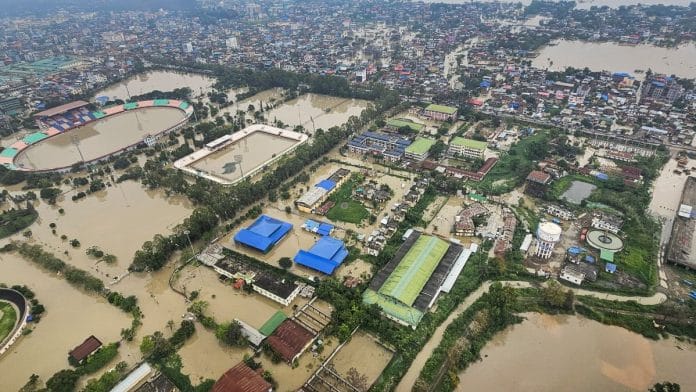New Delhi: India has experienced an unprecedented surge in incidence of extreme weather this year, with 255 out of 274 days—over 90 percent—marked by such events in the first nine months alone, a report from the Centre for Science and Environment (CSE) has said. This is the highest number of extreme weather days recorded in the past three years.
The report, published Friday, analysed extreme weather events, human and livestock fatalities, and crop damage across 36 states and Union Territories (excluding Dadra and Nagar Haveli, and Daman and Diu) from January 1 to September 30 of this year.
Seven of the nine months in 2024 saw extreme weather events every day—a record-breaking pattern that extended beyond the typical monsoon months, and into January and April. These events, including heat and cold waves, cyclones, lightning, heavy rain, floods, and landslides, resulted in 3,238 fatalities, affected 3.2 million hectares of crops, destroyed over 2,35,000 houses, and led to the loss of around 9,457 livestock, according to the CSE report.
“Extreme weather, once rare, has become a frequent reality across India due to climate change, with all regions—Northwest, East and Northeast, South, and Central—experiencing a significant rise in severe events,” said Rajit Sengupta, associate editor, Down To Earth, and co-author of the report. “Our nationwide analysis reveals that no part of the country is immune to these impacts.”
Also Read: No star power at COP29. Heads of key countries plan to sit out climate summit
Regional & seasonal trends
According to a state-wise analysis by experts at the CSE, based on official Indian Meteorological Department (IMD) records, Madhya Pradesh experienced the highest frequency of extreme weather events, with occurrences nearly every other day.
A broader regional analysis revealed that Central India recorded the most extreme weather days, with 218 such occurrences. The Northwest came in second, with only five fewer days of such events.
“A significant impact of climate change was seen across all seasons, with extreme weather events affecting 19 states and UTs during winter, 34 during the pre-monsoon, and 35 during the monsoon,” said the report.
The monsoon period—June to September—experienced extreme weather on all 122 days, while the pre-monsoon period saw events on 90 percent of the days, with 83 of 92 days affected. Winter, too, was not immune, with extreme weather recorded on 50 of the 60 days during the season.
CSE’s assessment found that the winter months recorded 38 days of cold waves, 17 days of lightning and storms, five days of heavy rain, floods and landslides, and one day of snowfall. Punjab and Haryana were hit the hardest with 34 extreme weather days. Uttar Pradesh and Rajasthan had 27 and 26 such days, respectively.
During the pre-monsoon period, lightning and storms occurred on 71 days, heatwaves on 54 days, and heavy rains, floods and landslides on 40 days. Madhya Pradesh experienced the most extreme weather, with 49 days affected, while Maharashtra recorded 44 days of such events.
The monsoon period saw extreme weather on 122 days due to heavy rains, floods and landslides, with lightning and storms on 103 days, heatwaves on 23 days, cloudbursts on 14 days, and cyclones on four days. Assam faced the most extreme weather with 111 days, followed by Madhya Pradesh and Uttar Pradesh (105 days each).
‘High crop damage, but numbers likely underreported’
To assess the impact of extreme weather, the report used data from the Disaster Management Division (DMD) of the Union Ministry of Home Affairs, supplemented by media reports. It found that deaths linked to extreme weather have risen by 18 percent over the past three years, with 3,238 deaths reported so far this year.
Kerala accounted for the highest number of fatalities, with 550 deaths, or 17 percent of the total figure. Madhya Pradesh ranked second with 353 deaths (11 percent) and Assam was third on the list with 256 deaths (eight percent).
Andhra Pradesh reported the highest number of damaged houses at 85,806. Despite experiencing fewer extreme events—142 days—compared to Madhya Pradesh (176 days), Maharashtra accounted for over 60 percent of the total affected crop area nationwide, while Madhya Pradesh saw 25,170 hectares impacted.
The report indicated that the highest number of deaths—over 40 percent, or 1,376 fatalities—were caused by floods. While heatwaves caused 210 deaths, the figure doesn’t account for the prolonged health effects of extreme temperatures on vulnerable groups in north India, such as farmers and labourers, who endured intense heat with few resources for relief.
The researchers also noted that damage to crops and property from other weather events, like cold waves and flooding, has shown a significant increase, but it is not fully accounted for, leaving at-risk communities more exposed to climate shocks.
“It is very likely that even these reported damages are underestimated due to incomplete data collection on event-specific losses, particularly on public property and crop damages,” said the report.
The absence of a comprehensive national database on weather events has hindered tracking of cumulative losses, with only monsoon reports provided by some state governments. Since 2024, national-level reports have been discontinued and existing databases have gaps in information on crop damage.
“The country must enhance its ability to estimate loss and damage more accurately and expand insurance coverage to better protect communities from the devastating impacts of extreme weather,” said Sengupta.
(Edited by Mannat Chugh)
Also Read: Plummeting bus ridership, explosion of cars, Delhi’s mobility crisis is driving up winter pollution






